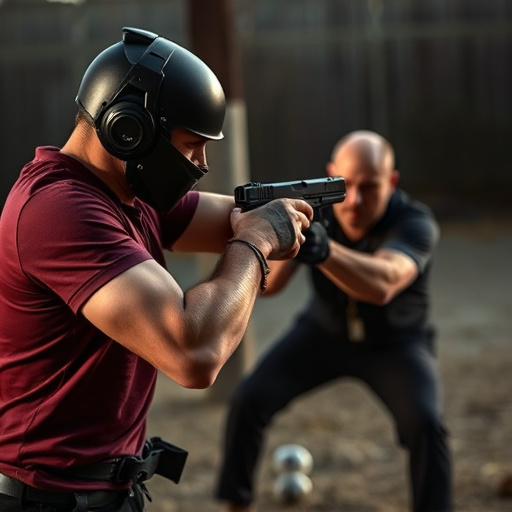Understanding pepper spray's effects duration is key for self-defense. Time varies from 30 seconds to several minutes based on capsaicin concentration, weather, and attacker tolerance. Correct usage within its range (3-4 meters) ensures maximum disruption before dissipating. Legal considerations vary by jurisdiction; understand local laws and spray properties for effective yet lawful defense.
Aerosol spray, particularly pepper spray, is a common defense mechanism against attackers. This article delves into the intricate world of aerosol spray defenses, focusing on its basics, effectiveness, and legalities. We explore critical factors influencing pepper spray duration, including distance analysis and long-term visual impacts. By understanding these aspects, individuals can make informed decisions about self-defense strategies, especially in today’s safety-conscious landscape. Learn about the science behind aerosol sprays and their effect on how long they disable attackers.
- Understanding Aerosol Spray Basics
- Factors Affecting Pepper Spray Duration
- Effective Distance and Range Analysis
- Long-Term Effects on Attacker's Vision
- Legal Considerations and Usage Guidelines
Understanding Aerosol Spray Basics
Aerosol spray, often known as pepper spray, is a non-lethal self-defense tool designed to temporarily incapacitate an attacker. At its core, it’s a fine mist composed of capsaicin, the active ingredient found in chili peppers. When deployed, this mist enters the eyes and nasal passages, causing temporary blindness, coughing, and difficulty breathing. Understanding how long pepper spray effects last is crucial for users to make informed decisions during emergencies.
On average, the effects of aerosol spray can last from 30 seconds to several minutes. Factors influencing its duration include the concentration of capsaicin, weather conditions, and the attacker’s tolerance to spice. Despite popular belief, pepper spray does not cause permanent damage. However, its temporary but intense effects can provide users with precious time to escape dangerous situations.
Factors Affecting Pepper Spray Duration
The duration for which pepper spray remains effective can vary significantly, depending on several factors. One key determinant is the concentration of capsaicin, the active ingredient responsible for the burning sensation and subsequent irritation. Higher concentrations generally result in longer-lasting effects, often lasting between 20 to 60 minutes. However, lower concentrations may only provide temporary relief, wearing off within a few minutes.
Environmental conditions play a crucial role as well. Wind can dissipate pepper spray quickly, reducing its potency and duration. Humidity levels also impact how long the spray remains active; higher humidity might shorten its effect time, while drier air allows the capsaicin to linger longer. Temperature is another factor; in colder climates, pepper spray can remain potent for extended periods compared to warmer environments where it may evaporate faster.
Effective Distance and Range Analysis
The effectiveness of aerosol spray defense, such as pepper spray, depends on proper usage and understanding its range and distance capabilities. When deployed correctly, a single burst can create a defensive barrier up to 3–4 meters away, providing crucial time for escape or backup. However, the duration of its effects varies; typically, pepper spray incapacitates an attacker for around 30 seconds to several minutes, depending on factors like concentration and weather conditions.
Knowing how long pepper spray effects last is essential for users to anticipate its impact. While it offers a brief window of protection, it’s not a permanent solution. Users should be trained to apply it strategically, aiming for the face and eyes to maximize disruption during an attack, ensuring they can retreat to safety or call for help before the spray dissipates.
Long-Term Effects on Attacker's Vision
When exposed to aerosol spray, such as pepper spray, an attacker’s vision is significantly impacted. The active ingredient in these sprays, capsaicin, irritates the eyes and can cause temporary blindness or reduced visibility for several minutes. This disorienting effect can give the defender valuable time to escape or regroup.
The duration of these visual impairments varies depending on the concentration of the spray and the individual’s sensitivity. Typically, the effects can last from 15 to 60 minutes, during which time the attacker may experience tearing, pain, and difficulty focusing. In some cases, pepper spray can even lead to long-term sensitivity or damage to the eyes if not used properly or if the victim is wearing contact lenses.
Legal Considerations and Usage Guidelines
When considering aerosol spray defense, it’s crucial to understand the legal implications and usage guidelines that govern its employment. The legality of pepper spray varies by jurisdiction, with some regions permitting its use only for self-defense while others allow law enforcement and security personnel to carry it. In many places, civilian possession and use are strictly regulated, often requiring permits or specialized training.
One important aspect to consider is the duration of effects from pepper spray. While immediate, intense discomfort and temporary blindness can incapacitate an attacker, these symptoms typically dissipate within minutes. However, how long these effects last can vary based on factors like the concentration of capsaicin, weather conditions, and individual sensitivity. Understanding local laws and the specific properties of the spray you intend to use is essential for lawful and effective self-defense.
Aerosol spray, particularly pepper spray, serves as a powerful personal defense tool when used properly. Understanding its basics, duration, range, and potential long-term effects on attackers is crucial. Knowing how long pepper spray effects last and adhering to legal guidelines ensure its effectiveness in high-stress situations. By staying informed about these key factors, individuals can make informed decisions and enhance their safety while navigating potentially dangerous encounters.
